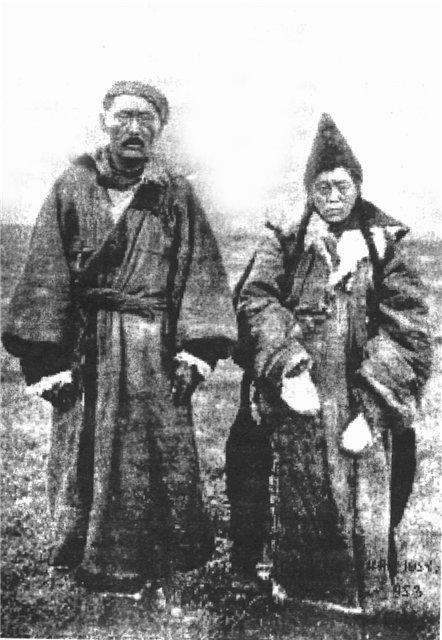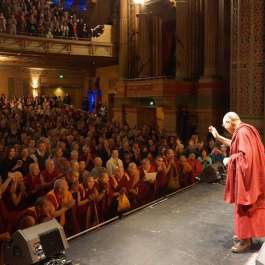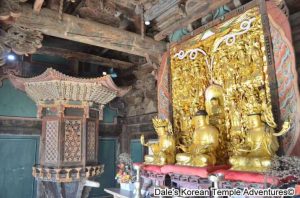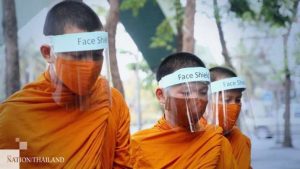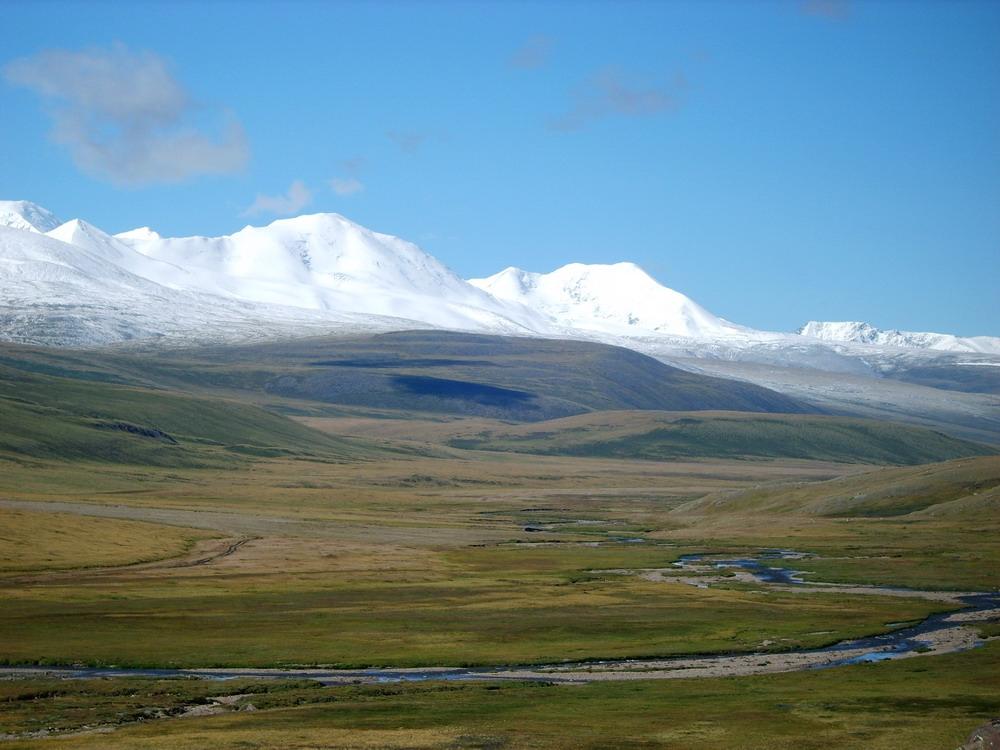
The dizzyingly beautiful Altai Mountains lie across Russian, Chinese, Mongolian, and Kazakh territory. Hüiten Peak is the second-highest summit in this magnificent range, and part of an imagined boundary between southwestern Siberia and the steppes of western Mongolia (go further south and you will find yourself in either the town of Ölgii or Ulaangom). The line dotted on maps between the prairie and the mountains marks the physical and existential border in the narrative of nationalists in the Republic of Altai.
In reality, a plain rock marked the so-called boundary between the Russian Empire and Qing-ruled Mongolia in the 18th century. “The Altaians were dual tributaries [dvoedantsy] of the Russian and Qing emperors, sending fur and pelts to both and traveling freely without regard for that rock. According to tsarist soldiers, it could barely even be seen amongst the grasslands,” says Andrei Znamenski of the University of Memphis, who spoke on a panel about Buddhism’s relations with other religions at the 17th IABS conference in Vienna in August (Znamenski 2014, 4).
Nothing has been the same since the “White Faith,” or Ak-Jang (now a revivalist movement called Burkhanism). A millenarian effort inspired by a man called Chet Chelpan in the 1900s, it imported Vajrayana from Mongolia as a spiritual anchor for local Altaians. Its rise was directly linked to the failure of Siberian shamans (who had no formal clerical structure or creeds around which to centralize authority) to resist Russian colonists (Znamenski 2014, 18–19) at the turn of the 20th century. The shamans were scorned, and clerical Vajrayana was embraced. A short-lived attempt by Altaians and their Russian allies to declare Burkhanist independence in 1918 ended with the crossfire between the Red and White Armies during the Russian Civil War (Znamenski 2014, 6–8). It was a Siberian version of Shambhala’s myth: the revolt of righteous Vajrayana Buddhists against oppressors of the Dharma.

Altaian hostility against the Russians is more muted today, and Burkhanism itself has become much more institutionalized. But Burkhanists have transmuted their past aggression into a broader native consciousness that reclaims Buddhism as their own. “They demand that their Tibetan Buddhism should be recognized as solely their own, a native tradition that was never imported from foreign lands like Mongolia,” says Professor Znamenski. “Enforcing borderlands and the idea of a ‘native Buddhism’ was an understandable reaction to Stalin’s persecutions against anyone who was open to foreign influences.” However, the pendulum has now swung the other way: “The nationalist narrative in Altai refuses to entertain the historical reality of porous borders between southern Siberia and Mongolia. It’s not only an incorrect way to construct an imagined community, it’s also unhelpful in healing the scars of the past and moving forward with an honest, common spiritual identity,” he insists.
At once sympathetic to and critical of revivalist Burkhanists, Prof. Znamenski knows a thing or two about borders. Exposed throughout his life to Orthodox Christianity, Catholicism, Native
American beliefs, communist atheism, and finally to Unitarian Universalism, his initial research interest was in shamanism (which culminated in a doctorate on Russian Orthodoxy among Alaskan Native Americans). This original interest was driven by aesthetic fascination. He has since spent decades researching shamanic traditions. “I was drawn, like many Westerners, to the mystique and primal pull of the shaman’s drum, their feathered caps, all the paraphernalia and traditions.” But curiously enough, it was also through shamanism that he came to involve himself in the study of Tibetan Buddhism and to take an interest in how southern Siberia is a sorely neglected region for scholars of Buddhist Studies.
Altai historical memory begins with the destruction of the Jungar Empire, the last great steppe civilization, at the hands of the Qianlong emperor (r. 1735–96). “The ethnic minorities of Russia’s Buddhists—Tuvans, Buryats, Kalmyks, and Altaians—trace their ancestry back to the Jungars,” says Prof. Znamenski. Chet Chelpan and other messianists who brought traits of Vajrayana to Altai were inspired by legends around a failed Jungar prince called Amursana, who fled to Siberia and died of the plague in 1757 after a failed uprising against the Manchus. There are Altai and west Mongolian versions, but the former claims that a savior figure by the name of Oirot ruled in peace until the Chinese army destroyed his people, a reference to the Qing genocide of the Jungars. Oirot retreated to Russia, where he settled down with the “maiden-khan,” an unnamed Russian empress (or as the Altais call her, baala or paala khan; Znamenski 2014, 4), and prophesied he would return in 120 years to take revenge.
The irony seems lost on Altai nationalists that this savior figure, in both the Altai and Mongolian versions of the tale, fell in love and sired a child with the Russian empress, who should have been the symbol of oppression against the Jungars’ descendants par excellence. The White Faith embraced Vajrayana for the sole purpose of resisting Russia. These bloopers in folklore tend to occur when there is some lack of self-awareness, and the blind spot for nationalist Altaians was their refusal to acknowledge how their Vajrayana identity could not have existed without crossing over their self-imposed borderlands.
Since the entire history of Altaian nationalist resistance would not have happened without the import of Vajrayana into southern Siberia, Prof. Znamenski believes there are lessons for the ways in which religions evolve. Restrictive, imaginary borders not only impede interfaith understanding or cross-cultural dialogue, but also restrict the potential diversity of spirituality itself. “Western Tibetan Buddhism began as a ‘fiction’ because the original form of Vajrayana had no understanding of human rights, feminism, or secularism,” he says. “Yet it adapted, so how can we still say American Vajrayana is a fiction today?”
There is no such thing as a so-called “pure” Vajrayana Buddhism. But that might not be a bad thing, because it simply means that throughout history, Vajrayana has been open to inspiring and being inspired by a variety of cultures and peoples. Purity is not as desirable as one assumes: it can indicate insularity and closed-mindedness. “For me, every religious tradition is authentic as long as it is embraced in good faith by sincere people,” concludes Prof. Znamenski thoughtfully. And perhaps there lies the true inner borderland, the existential frontier of the human condition: how to relate to the transcendent authentically.
References
Znamenski, Andrei. “Power for the Powerless: Oirot/Amursana Prophecy in Altai and Western Mongolia, 1890s–1920s.” Études mongoles et sibériennes, centrasiatiques et tibétaines 45 (30 June 2014): 2–23. Accessed online 29 September 2014. doi: 10.4000/emscat.2444.
Back to IABS Special Issue Homepage


